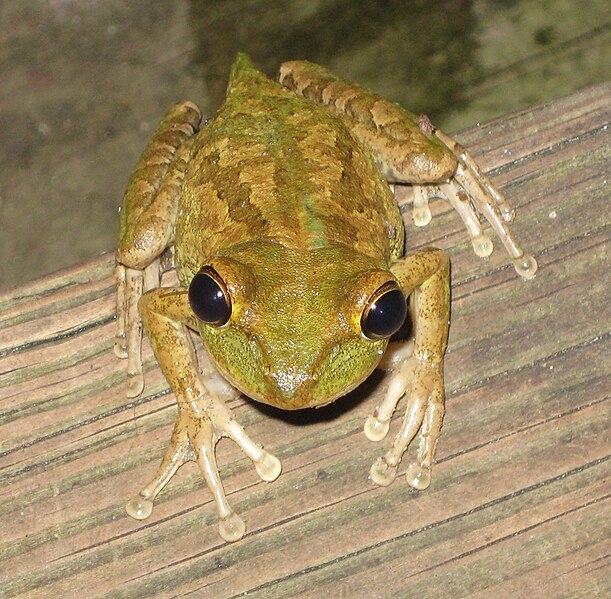Many interesting field research reports are published in professional journals such as Copeia, Herpetologica and Herpetological Review, and are not available on the internet. From time to time I’ll provide summaries of some of the fascinating articles that I come across. Today’s report, drawn from Autumn, 2010 publications, covers a favorite topic of mine – feeding records. As theses reports show, snakes and frogs often do battle – and the results are hard to predict!
Fer-de-lance and Smoky Jungle Frogs: Venom vs. Poison
In Costa Rica, a Fer-de-lance partially swallowed and regurgitated a Smoky Jungle Frog. The snake was rendered lethargic incapable of defending itself for at least 45 minutes (and would likely not repeat the experience!). Smoky Jungle Frogs produce Leptotoxin, a powerful chemical that causes rapid death from cardiac arrest when administered to rats. People have reported experiencing “tingling” sensations after handling Smoky Jungle Frogs.
Frog skin toxins can persist for surprisingly long times on some surfaces, and are real concerns in captive collections. Years ago, a co-worker of mine transported a Pickerel Frog in a plastic bucket that was later used to house several Blomberg’s Toads (there is some confusion as to whether or not the bucket was thoroughly cleaned in-between). Several Blomberg’s Toads died after a short time in the bucket; an autopsy showed evidence of toxin ingestion via the skin.
Cuban Treefrogs and their Prey
In Juniper, Florida, a Cuban Treefrog was observed consuming a Ring-necked Snake much larger than itself. This introduced predator has also been known to take Florida Brown Snakes, and is likely causing problems for Florida’s native treefrogs, all of which are smaller than the Cuban.
 A group of Cuban Treefrogs that I established in a greenhouse (Bronx, NY) subsisted largely on roaches and moths, but definitely also reduced the population of Green Anoles and House Geckos that shared their habitat.
A group of Cuban Treefrogs that I established in a greenhouse (Bronx, NY) subsisted largely on roaches and moths, but definitely also reduced the population of Green Anoles and House Geckos that shared their habitat.
American and African Bullfrogs are champion eaters…please see the video and article below for some interesting observations and footage.
Further Reading
Amazing Video: Bullfrog Swallows Bird
African and American Bullfrog Meals (Cobras included!)
Fer de Lance image referenced from wikipedia and originally posted by Al Cortiz
 That Reptile Blog – Reptile, Amphibian and Exotic Pet Care and Information
That Reptile Blog – Reptile, Amphibian and Exotic Pet Care and Information



Hallo Frank
Your articles just keep on being immense interesting! Thanxzzz!
I, unfortunately did not have the privilege (or was not observant enough) of encountering these feeding wonders of our bull frogs.
How ever, I did encounter similar while feeding a seemingly very plain frog to my centipede….
As soon as the frog landed in the bowl of the centipede, it was “hauled in” by the centipede! As the centipede curled in over the seemingly, motionless frog, it tried to get a spot to inject its mandibles in the frog….I could not watch (call me softy-but these things sometimes get to me…LOL) and decided to take a look after an hour or so….
Well, that hour went by and to my amazement the frog was well alive…as well as the centipede. It how ever never again tried to get the frog and rather enjoyed the cockroaches instead.
This only adds to the little I know the more I discover!
Best regards
Gert
Hello Gert, Frank Indiviglio here.
Thanks for your comment and observations…kind and interesting as always!
The centipede had likely been put off by the taste of the skin toxins…not an easy task! Not surprised by your reaction to the feeding event – I never feed them vertebrates, as they begin feeding long before the prey has expired, much like mantids. I’ve read of lifelong naturalists killing them because they could not bear to watch – Ivan Sanderson, in one of his books set in Africa, recounts doing so to a mantid that had grabbed a small mouse, if I remember correctly. They will take anything in the wild (this article has a link to a centipede catching bats in Trinidad), but captives do fine on an insect-only diet.
Please let me know if you need any further information. Good luck, enjoy and please keep me posted.
Best regards, Frank Indiviglio.